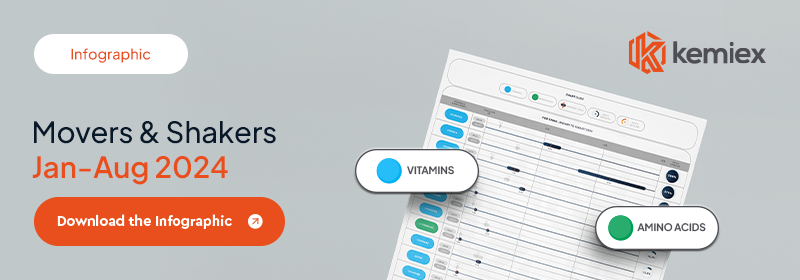
Infographic: Movers and Shakers Jan-Aug 2024
In today’s global market, businesses globally face an ever-increasing range of challenges that can significantly impact the supply and pricing of key raw materials. Geopolitical tensions, environmental regulations, and economic shifts are just some of the factors that contribute to uncertainty when making decisions. However, it’s often the unexpected events—such as natural disasters, pandemics, or sudden changes in supply and demand—that can lead to rapid, unpredictable price fluctuations and supply chain disruptions. In such a dynamic environment, the ability to react quickly and make informed decisions becomes critical for staying competitive.
This volatility is particularly evident in industries that depend on raw materials, where price and availability can shift dramatically, and where information is not always easily available. For example, supply disruptions or sudden demand spikes can lead to skyrocketing costs for essential products, putting financial pressure on businesses. On the other hand, drops in prices can also negatively impact an industry, leading to reduced revenues for suppliers and destabilising the market, as businesses may struggle to adjust their strategies to the fluctuating values or be left with significant losses in the value of their stocks. When market conditions change unexpectedly, companies need to have the right tools to respond promptly and avoid costly missteps.
This infographic showcases these market realities. Prices of products like Vitamin D3, Vitamin A and Vitamin E surged dramatically between January and August. Vitamin D3, for instance, saw its average price increase from 6.96 USD/kg in January to 33.99 USD/kg by August. Vitamin A saw its price range from a minimum of 17 USD/kg to a maximum of 85 USD/kg, which represents a fivefold increase between the two. At the same time, Amino acids such as L-Valine or L-Tryptophan had their average prices decrease by 20% between January and August. Both extremes are stark reminders of how volatile markets can become in a matter of weeks or even days.
In these situations, tools like Kemiex become invaluable. They provide real-time access to price benchmarks and market trends, enabling businesses to react swiftly to unexpected market shifts. Having this data at hand can be the difference between mitigating risks or being blindsided by unforeseen changes, ensuring companies remain agile and informed amid global uncertainties.
